Anonymous Signing
Table of Contents
1. Introduction
This is general walk-through for getting start iAM Smart APIs development of Anonymous Signing use case.
Developers of Online Services adopting iAM Smart may find this guide useful when designing and developing application flows for anonymous digital signing adopting iAM Smart functions.
In this guide we will provide guides on:
- Setting up your iAM Smart development environment
- Request Anonymous Signing
- Obtain Anonymous Signing Result
- Online Service Acknowledges Signing Result
2. User Journey
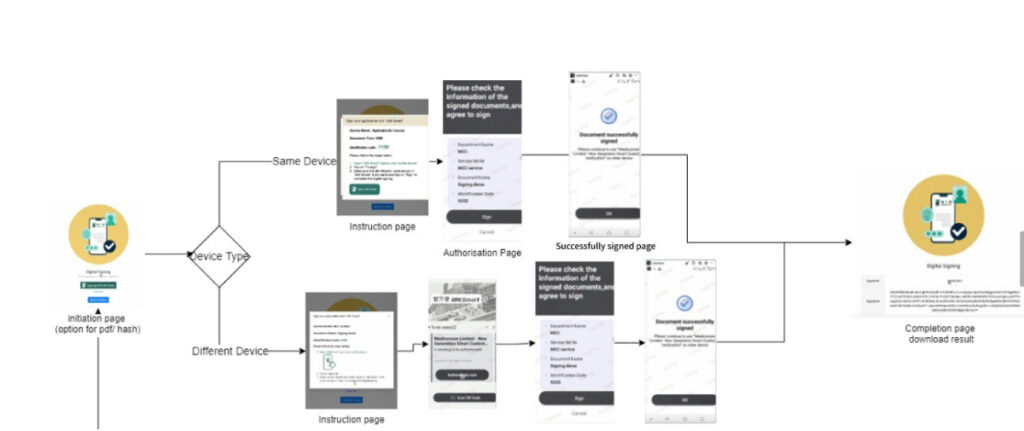
3. Flow
Please find below the sequence diagram for the whole digital signing process:
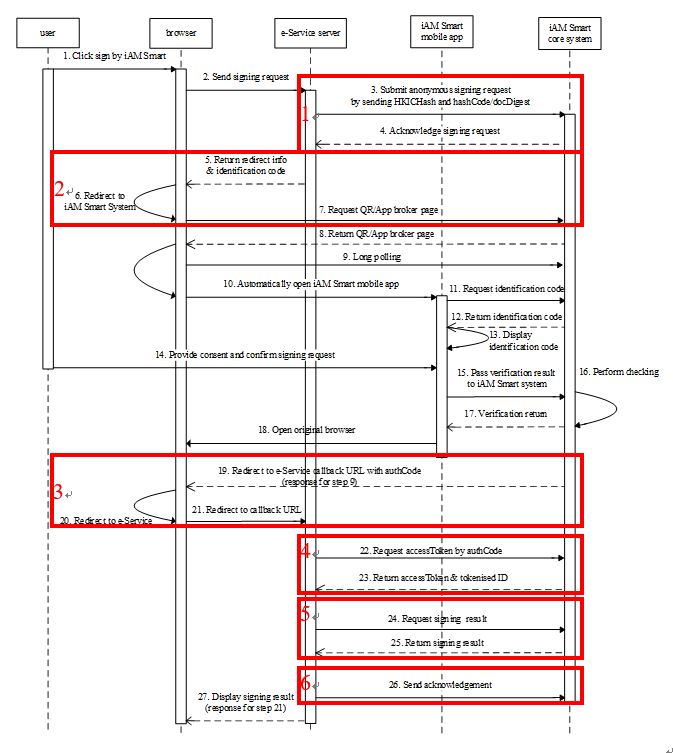
In this guide, we will focus on some of the key steps that online service and users will be involved into when adopting and using “iAM Smart”.
4. Click sign by iAM Smart
| Digital Signing | |
| Traditional Chinese | 智方便數碼簽署 |
| Simplified Chinese | 智方便数码签署 |
| English | Signing with iAM Smart |
| Sample Button for Digital Signing | |
| Traditional Chinese | |
| Simplified Chinese | |
| English | |
| Open “iAM Smart” | |
| Usage | The button for user open specific authorisation page in “iAM Smart” mobile app. |
| Traditional Chinese | 開啟智方便 |
| Simplified Chinese | 开启智方便 |
| English | Open iAM Smart |
| Sample Button for Open iAM Smart | |
| Traditional Chinese | |
| Simplified Chinese | |
| English | |
Continue with iAM Smart | |
Usage | For Anonymous Flow only |
Traditional Chinese | 以智方便繼續 |
Simplified Chinese | 以智方便继续 |
English | Continue with iAM Smart |
Sample Button for Continue with iAM Smart | |
Traditional Chinese | |
Simplified Chinese | |
English | |
Online services is required to add a link / button, “More info” or “了解更多” in the initiation page. The link / button shall be linked to the “iAM Smart” thematic webpage based on language preference of user. The initiation page refers to the page that initiates the “iAM Smart” service, which user clicks the “iAM Smart” button to initiate the interaction with “iAM Smart” mobile application.
Language | Link |
English | https://www.iamsmart.gov.hk/en/ |
Traditional Chinese | https://www.iamsmart.gov.hk/tc/ |
Simplified Chinese | https://www.iamsmart.gov.hk/sc/ |
5. Submit “Request Anonymous Signing”
5.1 Composing Request Body
Parameter | Type | Presence | Description |
| businessID | String | Required | businessID is a unique identifier for Online Service to differentiate different request. It could be ASCII string with length less than or equal to 36 chars. |
| hashCode | String | Required | the document hash to be signed. Online Service should compute the hash and send this hash to iAM Smart System for signing. The value should be Base64 encoded. |
| sigAlgo | String | Optional | signature algorithm to be used. Online Service can specify either SHA256withRSA or NONEwithRSA. The default value is SHA256withRSA. While using NONEwithRSA, hashCode provided must be hashed with SHA256 |
| HKICHash | String | Required | Signing request will only be processed when the hash of the HKIC number of the iAM Smart user is matched with the HKICHash provided by Online Service. Online Service should convert the HKIC number into hash value using SHA256 before sending to iAM Smart System. Only the identifier of HKIC number will be hashed, no check digit is needed e.g. A123456. The value should be Base64 encoded. |
| department | String | Optional | The department that initiates the signing request |
| serviceName | String | Required | The service name |
| documentName | String | Required | The document name that the user is going to sign |
Your request body should look something like this:
POST
https://<iAM_Smart_domain>/api/v1/anonymous/signing/initiateRequest
// Request Headers
clientID: "edae2e2529ff46228af1e4d18c8405d1"
signatureMethod: "HmacSHA256"
signature: "5X42Y1B7MEd8Mm%2BonwjiQz9VCZkkrntADskXsYntavU%3D"
timestamp: 1557048906183
nonce: "e893647dc4204eb9b7b8eddd527b687c"
// Request Body
{
"businessID": "bbb8aae57c104cda40c93843ad5e6db8",
"hashCode": " 965e638fda4c70f667efc2d68c40c6111e5965bfc82356d",
"HKICHash": " 6ea37e641260714009a880a8057032a414009a80f667efc",
"department": " Office of the Government Chief Information Officer",
"serviceName": "Online Service1",
"documentName": "Doc0001"
}
Encryption
To better protect the data in transit, an additional layer of data encryption will be applied to all APIs POST request (except the one that Online Service request for getting symmetric encryption key)
| Info |
| To encrypt the data, a Content Encryption Key is required, please refer to iAM Smart API Specification 6.3.1.1 or online mockup API. |
In this case we will use a mock-up Content Encryption Key (CEK), please find below a base64-encoded mock CEK:
pvD2Zc1mf7tKVh17JOftmzyTaDyVmcULg92nB9qeEoQ=
You may refer to the pseudo code below for the encryption implementation:
private static final String AES_GCM_NOPADDING = "AES/GCM/NoPadding";
/**
* AES GCM encryption
* @param contentByte - Bytes of content to be encrypted
* @param key - CEK (AES 256)
* @return
*/
public static String encrypt(byte[] contentByte, byte[] key) {
SecretKeySpec skeySpec = new SecretKeySpec(key, AES);
byte[] encrypted = null;
try {
SecureRandom secureRandom = new SecureRandom();
byte[] iv = new byte[12];
// do not reuse iv with the same key
secureRandom.nextBytes(iv);
Cipher cipher = Cipher.getInstance(AES_GCM_NOPADDING);
GCMParameterSpec parameterSpec = new GCMParameterSpec(128, iv);
cipher.init(Cipher.ENCRYPT_MODE, skeySpec, parameterSpec);
encrypted = cipher.doFinal(contentByte);
ByteBuffer byteBuffer = ByteBuffer.allocate(
4 + iv.length + encrypted.length);
byteBuffer.putInt(iv.length);
byteBuffer.put(iv);
byteBuffer.put(encrypted);
byte[] cipherMessage = byteBuffer.array();
return Base64Util.base64Encode(cipherMessage);
} catch (NoSuchAlgorithmException | NoSuchPaddingException
| InvalidKeyException | InvalidAlgorithmParameterException
| IllegalBlockSizeException | BadPaddingException e) {
log.error("Encryption error: {}", e);
throw new IAMSmartException(e);
}
}
Note |
Please note that the pseudo code ONLY aims for reference and shall provide NO SUPPORT for any issue on the pseudo code. |
Please find below an example of base64-encoded IV:
vM7EArooK0hCCX8E
If you use the above json and encrypt with the above CEK and IV, concatenated and base64 encoded, you should get the following result:
AAAADLzOxAK6KCtIQgl/BJRVECazUaNiaf13rfcGNApA3K0BI0qZkB5pMWAjcTF0z0PLOnsCyxCtVUytAbA/cm2U5W83FrRXvtZZ74SrCWY4cQiAlq38TLSeOY9B418Tc5dUr1JnbCVeHe8HNrEY81QyI3r7JMZfXGaWgRoz0os8C7zbzty88vPGPSmBE7WqZF5I84IJ7wzwpRs+ifz9DfpFqWzj55mftTHQERWDhcKRALgdZECoFCqtmNhRFERxAm+MrIkypZG/JAdcho0cLyIGTkw7KLqKT0/NmQgQ3vsi6IxGOF4u8gPfLHfRkLopZkU7sXXHNC5hVtEmGXz0zrp+Pq9diKIX6MyrAtwjhIxxKu5iI9MO7XB272hpeonpJYWA0dvh0F882tjNnN6oRJrQ1ZxPXfeA
Now put it in the value of JSON name/value pair called “content” as the request body:
{"content": "AAAADLzOxAK6KCtIQgl/BJRVECazUaNiaf13rfcGNApA3K0BI0qZkB5pMWAjcTF0z0PLOnsCyxCtVUytAbA/cm2U5W83FrRXvtZZ74SrCWY4cQiAlq38TLSeOY9B418Tc5dUr1JnbCVeHe8HNrEY81QyI3r7JMZfXGaWgRoz0os8C7zbzty88vPGPSmBE7WqZF5I84IJ7wzwpRs+ifz9DfpFqWzj55mftTHQERWDhcKRALgdZECoFCqtmNhRFERxAm+MrIkypZG/JAdcho0cLyIGTkw7KLqKT0/NmQgQ3vsi6IxGOF4u8gPfLHfRkLopZkU7sXXHNC5hVtEmGXz0zrp+Pq9diKIX6MyrAtwjhIxxKu5iI9MO7XB272hpeonpJYWA0dvh0F882tjNnN6oRJrQ1ZxPXfeA" }
5.2 Composing Common Request Header
| Parameter | Type | Presence | Description |
| clientID | String | Required | Online Service client identifier. The clientID will be assigned to online service at the initial registration |
| signatureMethod | String | Required | signature algorithm: HmacSHA256 |
| timestamp | Long | Required | The timestamp is the request submit time expressed in the number of milliseconds since January 1, 1970 00:00:00 GMT. It is used to prevent replay attack. The value MUST be a positive integer and equal or greater than the timestamp used in previous requests. |
| nonce | String | Required | A nonce is a random string, uniquely generated for each request by online service. It is used to prevent replay attack. A nonce can be an ASCII string of any length less than or equal to 36 (UUID string length) as long as the uniqueness requirement is met. |
| signature | String | Required | It is a signature of the submitted data. Online service uses clientSecret to sign the concatenated string of clientID, signatureMethod, timestamp, nonce, and request body to get the signature. The pseudo code to generate the signature is shown at below. |
Online Service uses clientSecret to sign the concatenated string of ClientID, signatureMethod, timestamp, nonce and request body to get the signature.
In this case, we will use the following parameters for signature generation:
clientID: clientID20220817demo
clientSecret: clientSecret20220817demo
signatureMethod: HmacSHA256
timestamp: 1660721425291
nonce: nonce20220817
The concatenated string of ClientID, singatureMethod, timestamp, nonce and request body should be as follow:
clientID20220817demoHmacSHA2561660721425291nonce20220817{"content": "AAAADLzOxAK6KCtIQgl/BJRVECazUaNiaf13rfcGNApA3K0BI0qZkB5pMWAjcTF0z0PLOnsCyxCtVUytAbA/cm2U5W83FrRXvtZZ74SrCWY4cQiAlq38TLSeOY9B418Tc5dUr1JnbCVeHe8HNrEY81QyI3r7JMZfXGaWgRoz0os8C7zbzty88vPGPSmBE7WqZF5I84IJ7wzwpRs+ifz9DfpFqWzj55mftTHQERWDhcKRALgdZECoFCqtmNhRFERxAm+MrIkypZG/JAdcho0cLyIGTkw7KLqKT0/NmQgQ3vsi6IxGOF4u8gPfLHfRkLopZkU7sXXHNC5hVtEmGXz0zrp+Pq9diKIX6MyrAtwjhIxxKu5iI9MO7XB272hpeonpJYWA0dvh0F882tjNnN6oRJrQ1ZxPXfeA"}
You may refer to the pseudo code below for the signature generation:
message = clientID + signatureMethod + timestamp + nonce + request_body
sha256_HMAC = Mac.getInstance("HmacSHA256");
secret_key = new SecretKeySpec(secret.getBytes(), "HmacSHA256");
sha256_HMAC.init(secret_key);
hash = Base64.encodeBase64String(sha256_HMAC.doFinal(message.getBytes()));
// If the hash needs to be URL encoded
signature = URLEncoder.encode(hash, "UTF-8")
With the parameters provided you should get the following result:
17uX5GHbU7x1mz1czXBLifRqOJ%2BwzZG105bj%2FWpuwU0%3D
Now construct the request header with all the parameters:
{
"clientID": "clientID20220817demo",
"signatureMethod": "HmacSHA256",
"timestamp": 1660721425291,
"nonce": "nonce20220817",
"signature": "17uX5GHbU7x1mz1czXBLifRqOJ%2BwzZG105bj%2FWpuwU0%3D"
}
The completed request should be like following:
[Post] https://<iAM_Smart_domain>/api/v1/auth/getToken
// Request Header
{ "clientID": "clientID20220817demo",
"signatureMethod": "HmacSHA256",
"timestamp": 1660721425291,
"nonce": "nonce20220817",
"signature": "17uX5GHbU7x1mz1czXBLifRqOJ%2BwzZG105bj%2FWpuwU0%3D" }
// Request Body
{"content": "AAAADLzOxAK6KCtIQgl/BJRVECazUaNiaf13rfcGNApA3K0BI0qZkB5pMWAjcTF0z0PLOnsCyxCtVUytAbA/cm2U5W83FrRXvtZZ74SrCWY4cQiAlq38TLSeOY9B418Tc5dUr1JnbCVeHe8HNrEY81QyI3r7JMZfXGaWgRoz0os8C7zbzty88vPGPSmBE7WqZF5I84IJ7wzwpRs+ifz9DfpFqWzj55mftTHQERWDhcKRALgdZECoFCqtmNhRFERxAm+MrIkypZG/JAdcho0cLyIGTkw7KLqKT0/NmQgQ3vsi6IxGOF4u8gPfLHfRkLopZkU7sXXHNC5hVtEmGXz0zrp+Pq9diKIX6MyrAtwjhIxxKu5iI9MO7XB272hpeonpJYWA0dvh0F882tjNnN6oRJrQ1ZxPXfeA" }
Upon success you should receive the encrypted response:
{
"txID": "<T=938ffb193b4b4370b6c2584372c6a588>",
"code": "D00000",
"message": "SUCCESS",
“secretKey”:"AAAADLzOxAK6KCtIQgl/BJRVECazUaNiaf13rfcGNApA3K0BI0qZkB5pMWAjcTF0z0PLOnsCyxCtVUytAbA/cm2U5W83FrRXvtZZ74SrCWY4cQiAlq38TLSeOY9B418Tc5dUr1JnbCVeHe8HNrEY81QyI3r7JMZfXGaWgRoz0os8C7zbzty88vPGPSmBE7WqZF5I84IJ7wzwpRs+ifz9DfpFqWzj55mftTHQERWDhcKRALgdZECoFCqtmNhRFERxAm+MrIkypZG/JAdcho0cLyIGTkw7KLqKT0/NmQgQ3vsi6IxGOF4u8gPfLHfRkLopZkU7sXXHNC5hVtEmGXz0zrp+Pq9diKIX6MyrAtwjhIxxKu5iI9MO7XB272hpeonpJYWA0dvh0F882tjNnN6oRJrQ1ZxPXfeA",
"content":"AAAADLzOxAK6KCtIQgl/BJRVECazUaNiaf13rfcGNApA3K0BI0qZkB5pMWAjcTF0z0PLOnsCyxCtVUytAbA/cm2U5W83FrRXvtZZ74SrCWY4cQiAlq38TLSeOY9B418Tc5dUr1JnbCVeHe8HNrEY81QyI3r7JMZfXGaWgRoz0os8C7zbzty88vPGPSmBE7WqZF5I84IJ7wzwpRs+ifz9DfpFqWzj55mftTHQERWDhcKRALgdZECoFCqtmNhRFERxAm+MrIkypZG/JAdcho0cLyIGTkw7KLqKT0/NmQgQ3vsi6IxGOF4u8gPfLHfRkLopZkU7sXXHNC5hVtEmGXz0zrp+Pq9diKIX6MyrAtwjhIxxKu5iI9MO7XB272hpeonpJYWA0dvh0F882tjNnN6oRJrQ1ZxPXfeA"
}
Decryption
The structure of the encrypted content of response body is the same as the encrypted request body:
4 bytes IV length + IV + ciphertext
To decrypt the encrypted content, you will have to locate the following data:
- 4 bytes IV length
- IV
- Ciphertext
- authTag (if necessary)
You may refer to the pseudo code below for the decryption implementation:
6. Calculate identification code
private static final String AES_GCM_NOPADDING = "AES/GCM/NoPadding";
/**
* AES GCM encryption
* @param contentByte - Bytes of content to be encrypted
* @param key - CEK (AES 256)
* @return
*/
public static String encrypt(byte[] contentByte, byte[] key) {
SecretKeySpec skeySpec = new SecretKeySpec(key, AES);
byte[] encrypted = null;
try {
SecureRandom secureRandom = new SecureRandom();
byte[] iv = new byte[12];
// do not reuse iv with the same key
secureRandom.nextBytes(iv);
Cipher cipher = Cipher.getInstance(AES_GCM_NOPADDING);
GCMParameterSpec parameterSpec = new GCMParameterSpec(128, iv);
cipher.init(Cipher.ENCRYPT_MODE, skeySpec, parameterSpec);
encrypted = cipher.doFinal(contentByte);
ByteBuffer byteBuffer = ByteBuffer.allocate(
4 + iv.length + encrypted.length);
byteBuffer.putInt(iv.length);
byteBuffer.put(iv);
byteBuffer.put(encrypted);
byte[] cipherMessage = byteBuffer.array();
return Base64Util.base64Encode(cipherMessage);
} catch (NoSuchAlgorithmException | NoSuchPaddingException
| InvalidKeyException | InvalidAlgorithmParameterException
| IllegalBlockSizeException | BadPaddingException e) {
log.error("Encryption error: {}", e);
throw new IAMSmartException(e);
}
}
You should get the following result:
{
"txID": "<T=938ffb193b4b4370b6c2584372c6a588>",
"code": "D00000",
"message": "SUCCESS",
"content": {
"accessToken": "0ad186353c424c64897fcc00445c9ba1",
"tokenType": "Bearer",
"issueAt": 1557053922938,
"expiresIn": 14400000, // 4 hours
"openID": "liR14%2BvX%2F5hSum5uf4ERczu0KcDnIJA5BM7FoM1ag9c%3D",
"lastModifiedDate": 1560849218006,
"userType": "sign",
"scope": "eidapi_auth eidapi_formFilling"
}
}
6. Calculate identification code
After online service initiates an anonymous signing request, iAM Smart System verifies and confirms receipt of the anonymous signing request to Online Service Server by returning POST response with parameter “tickerID”, online service server uses the Document Hash / PDF digest, HKICHash and hash of clientID to calculate a 4-digit identification code to inform iAM Smart user to process the signing authorisation request in iAM Smart Mobile App.
4-digit identification code generation algorithm is as follows:
- Concatenate the Document Hash and the Tokenised ID hash value (calculated with SHA-512), and perform the digital digest for the concatenation result with SHA-512.
- Perform the MD5 calculation to obtain a unique MD5 hash value.
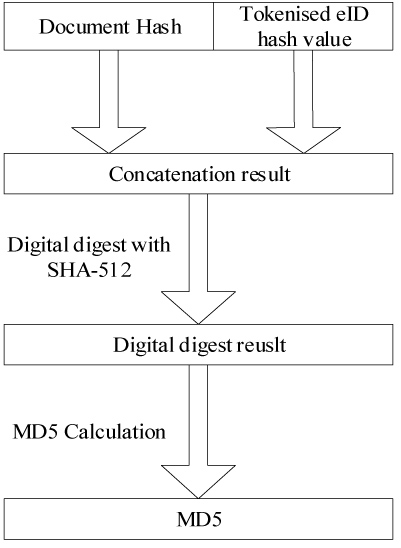
Divide the 128-bit MD5 hash value into four groups of 4 bytes binary value and then extract the fistt byte from each group as a data sample.
Perform 4-bit unsigned right shift to each byte of the result obtained above for the hexadecimal data.
Perform the modulo operation on each byte (modulo 10) to obtain a number of 0-9.
Assemble the 4 numbers obtained above as a 4-digit identificatin code.
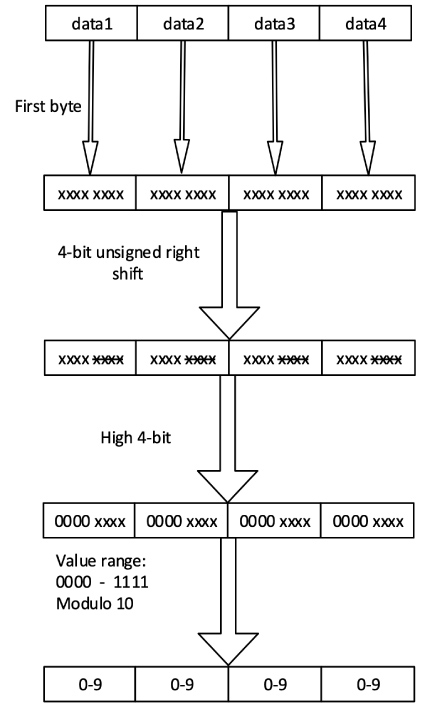
You may refer the pseudo code below for the calculation of identification code:
private static final char hexDigits[] = {‘0’, ‘1’, ‘2’, ‘3’, ‘4’, ‘5’, ‘6’, ‘7’, ‘8’, ‘9’};
public static String getSignCode (String hashCode, String openlD) {
// Assume Document Hash is BASE64 encoded and perform decode
byte[] hashCodeBytes = Base64Util.base64Decode(hashCode);
// Calculate SHA-512 hashcode of Tokenised ID
byte[] openlDBytes = DigestUtil.digestToByte(openlD, Alg.SHA512);
char code[] = new char [4];
byte[] source = new byte[hashCodeBytes.length + openlDBytes.length];
System.arraycopy(hashCodeBytes, 0, source, 0, hashCodeBytes.length);
System.arraycopy(openlDBytes, 0, source, hashCodeBytes.length, openlDBytes.length);
// Calculate SHA-512 hashcode from concatenated Document Hash and
// SHA-512 hashed Tokenised ID
byte[] inData = DigestUtil.digestToByte(source, Alg.SHA512);
// Calculate MD% hashcode
byte[] digestMD5Data = DigestUtil.digestToByte(inData, Alg.MD5);
// Convert MD5 value 4-digit identification code
for (int i = 0; i < 4; i++) {
code[i] = hexDigits[(digestMD5Data[i * 4] >>> 4 & 0xf) % 10];
return new String(code);
}
Note |
Please note that the pseudo code ONLY aims for reference and shall provide NO SUPPORT for any issue on the pseudo code. |
7. Instruction Page for requesting signing
After online service sends the initiate signing request to “iAM Smart” system, online service is required to instruct to open the “iAM Smart” app in his/her mobile phone. Please refer to the table below for different scenarios.
| Online service name | |||
| Document name | |||
| Identification code | |||
| Traditional Chinese | 識別碼: [9999] | ||
| Simplified Chinese | 识别码: [9999] | ||
| English | Identification code: [9999] | ||
| Instructions | |||
| Traditional Chinese | 請按照以下步驟:
| 請按照以下步驟:
| |
| Simplified Chinese | 请按照以下步骤:
| 请按照以下步骤:
| |
| English | Please follow the steps below:
| Please follow the steps below:
| |
| Example | 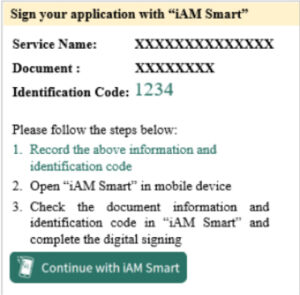 | 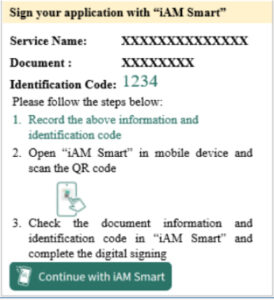 | |
8. Request QR Page/App broker page
Depending on your device, the construction of the request is different:
Web(Same Device) | #get QR page(same device) https://<iAM_Smart_domain>/api/v1/auth/getQR? clientID=clientID20220817demo &responseType=code &source=<source> &redirectURI=<redirect_URI> &scope=eidapi_formFilling &lang=en-US &state=8273829213458 &ticketID=561b6f1ce5a043ba8aae33fb5c50386d &brokerPage=True |
Web(Different Device) | #get QR page(different device) https://<iAM_Smart_domain>/api/v1/auth/getQR? clientID=clientID20220817demo &responseType=code &source=<source> &redirectURI=<redirect_URI> &scope=eidapi_formFilling &lang=en-US &state=8273829213458 &ticketID=561b6f1ce5a043ba8aae33fb5c50386d |
Mobile App(Same Device) | #open iAM Smart Mobile App for Getting Context <iAM_Smart_URL_Scheme>://anon_form-filling? ticketID=561b6f1ce5a043ba8aae33fb5c50386d &source=<source> &redirectURI=<redirect_URI> &state=8273829213458 |
Mobile App(Different Device) | #get QR page(different device) https://<iAM_Smart_domain>/api/v1/auth/getQR? clientID=clientID20220817demo &responseType=code &source=<source> &redirectURI=<redirect_URI> &scope=eidapi_formFilling &lang=en-US &state=8273829213458 &ticketID=561b6f1ce5a043ba8aae33fb5c50386d |
Tip |
Please make sure that the redirectURI has to be registered on the self-service portal (ESP). |
Upon request, user will proceed to open the “iAM Smart” Mobile App directly via URL Scheme of QR/Broker Page.
If user give consent to the request, webpage will return the code and state (if presented) to the redirectUri provided in the request through redirection.
<redirect_URI>?code=xxxa42e76bf4cb0846a68e6d83d6096&state=8273829213458 |
9. Verify businessID
When online service server gets the authCode and businessID, it needs to verify busineesID as generated when online service server initiates an anonymous signing request.
10. Request access token with auth_code
With the authCode received from the redirect endpoint, please construct the request body for requesting access token.
{ "code": "xxxa42e76bf4cb0846a68e6d83d6096", "grantType": "authorization_code" }
Note |
Same as the previous steps, you have to encrypt the request body and construct the request header accordingly. |
Now initiate the request with POST method to the access token endpoint.
https://<iAM_Smart_domain>/api/v1/auth/getToken
Upon success you should receive the encrypted response:
{ "txID": "<T=938ffb193b4b4370b6c2584372c6a588>", "code": "D00000", "message": "SUCCESS", "secretKey": "XlUu98zV6/W4LPDfZZxzOVY62e4PHZ1e3BzENgA/ysO+rxmnBlqmYRUOqYKS8Fj/6EpuCA1jsnNY/NJWh8KBz/Kxfe03I1SuD/lHemzMahXLc9x58ecGU0q59VRNO+powUdPTyu0EPH8izh8GQ+Ht33gicl4GMmXuwjmqoo4TZl6h4hPGf6al6piQ9gucsjgFpIoP9genqXqcDCmNkhLoLUMrk5t/ZsA97AP7DHAGh5RcUT3Qktwz+D1I7Nd4oWUS6yo8ci39epiYSrG9B06OZ/kVo7k6to1Q7KVoCKj3PsMJgCUVfOQ0HP1YnH599Cu4eyULaa3rIpafpycPvqh9g==", "content": "AAAADFaP8/FuTcoymbq2hswpgHER9BUM5itaTKWo2/UwtG4wWRsMgri9bSMZ6uLxjKgmGxKTiR/5N8JuqgX1WJjoMJHp8wnLgSU4FFuGr5yNuGiLpW62fmf95GdF/ikInE5zkzT3hJRzTXbdTALeXWWPu/88WyZn1REGqSs6m2AdMY5pIhgia8bCHBxSIPBGuBtAujMII7Nlb6ocFwUL0QuaZqPF/hNJWt/EI46YGHegKiRB6KP6hxg6K5I9Sz77uQfO60PV5833fnvU" }
After decryption you may retrieve the access token to obtain the form filling result:
{ "txID": "<T=938ffb193b4b4370b6c2584372c6a588>", "code": "D00000", "message": "SUCCESS", "content": { "accessToken": "0ad186353c424c64897fcc00445c9ba1", "tokenType": "Bearer", "issueAt": 1557053922938, "expiresIn": 14400000, // 4 hours "openID": "liR14%2BvX%2F5hSum5uf4ERczu0KcDnIJA5BM7FoM1ag9c%3D", "lastModifiedDate": 1560849218006, "userType": "sign", "scope": "eidapi_auth eidapi_formFilling" } }
11. Request “Obtain Anonymous Signing Request”
With the access token and the openID, please construct the request body for obtaining the signing result.
{ "accessToken": "xxxa42e76bf4cb0846a68e6d83d6096", "openID": "liR14%2BvX%2F5hSum5uf4ERczu0KcDnIJA5BM7FoM1ag9c%3D" }
Now initiate the request with POST method to the obtain Anonymous Signing endpoint.
https://<iAM_Smart_domain>/api/v1/anonymous/signing/initiateRequest
Upon success you should receive the encrypted response:
{ "txID": "<T=938ffb193b4b4370b6c2584372c6a588>", "code": "D00000", "message": "SUCCESS", "secretKey": "XlUu98zV6/W4LPDfZZxzOVY62e4PHZ1e3BzENgA/ysO+rxmnBlqmYRUOqYKS8Fj/6EpuCA1jsnNY/NJWh8KBz/Kxfe03I1SuD/lHemzMahXLc9x58ecGU0q59VRNO+powUdPTyu0EPH8izh8GQ+Ht33gicl4GMmXuwjmqoo4TZl6h4hPGf6al6piQ9gucsjgFpIoP9genqXqcDCmNkhLoLUMrk5t/ZsA97AP7DHAGh5RcUT3Qktwz+D1I7Nd4oWUS6yo8ci39epiYSrG9B06OZ/kVo7k6to1Q7KVoCKj3PsMJgCUVfOQ0HP1YnH599Cu4eyULaa3rIpafpycPvqh9g==", "content": "AAAADFaP8/FuTcoymbq2hswpgHER9BUM5itaTKWo2/UwtG4wWRsMgri9bSMZ6uLxjKgmGxKTiR/5N8JuqgX1WJjoMJHp8wnLgSU4FFuGr5yNuGiLpW62fmf95GdF/ikInE5zkzT3hJRzTXbdTALeXWWPu/88WyZn1REGqSs6m2AdMY5pIhgia8bCHBxSIPBGuBtAujMII7Nlb6ocFwUL0QuaZqPF/hNJWt/EI46YGHegKiRB6KP6hxg6K5I9Sz77uQfO60PV5833fnvU" }
After decryption you may retrieve the access token to obtain the signing result:
{
"txID": "<T=938ffb193b4b4370b6c2584372c6a588>",
"code": "D00000",
"message": "SUCCESS",
"content": {
"businessID": "2YotnFZFEjr1zCsicMWpAA",
"state": "unesidkd",
"hashCode": "tGzv3JOkF0XG5Qx2TlKWIA",
"timestamp": 1556450176000,
"signature": "nnoadisauflanefhykdjf",
"cert": "sdfGSDGsdfaGDEHfjslgGQG……GSGjljlkjwmh",
}
}
12. Online Service Acknowledge Signing Result
Online service completes the document signing process, verify the result and acknowledge iAM Smart System the signing result using iAM Smart API with the same “businessID” of the signing request.
You may refer the pseudo code below for the verification of signing result:
public static boolean verifySignature(PublicKey publicKey, String algName, byte[] signatureByte, byte[] hash) {
boolean isCorrect = false;
try {
Signature signature = Signature.getInstance(algName);
signature.initVerify(publicKey);
signature.update(hash);
isCorrect = signature.verify(signatureByte);
} catch (NoSuchAlgorithmException | InvalidKeyException | SignatureException e) {
e.printStackTrace();
}
return isCorrect;
}
12.1 Composing Request body
| Parameter | Type | Presence | Description |
| businessID | String | Required | businessID is a unique identifier for Online Service to differentiate different request. It should be ASCII string with length less than or equal to 36 chars. |
| signingResult | String | Required | “SR001”: digital signature is accepted “SR002”: digital signature is rejected “SR003”: no digital signature was received |
Your request body should look something like this:
https://<iAM_Smart_domain>/api/v1/account/signing/ackResult
// Request Headers
clientID: "edae2e2529ff46228af1e4d18c8405d1"
signatureMethod: "HmacSHA256"
signature: "5X42Y1B7MEd8Mm%2BonwjiQz9VCZkkrntADskXsYntavU%3D"
timestamp: 1557048906183
nonce: "e893647dc4204eb9b7b8eddd527b687c"
// Request Body
{
"businessID": "bbb8aae57c104cda40c93843ad5e6db8",
"signingResult": "SR001",
}
As an additional layer of data encryption will be applied to all APIs POST request, please follow above section to construct the encrypted request header and request body.
Upon success you should receive the encrypted response:
{
"txID": "<T=938ffb193b4b4370b6c2584372c6a588>",
"code": "D00000",
"message": "SUCCESS"
}
Decryption
Please refer to above section for decryption of the content data, and you should get the following result:
{
"txID": "<T=938ffb193b4b4370b6c2584372c6a588>",
"code": "D00000",
"message": "SUCCESS"
}
Online service server matches the result using the “businessID” and shows the signing result in corresponding online service website.